Pogostemon helferi is widely famous among aquarists. They use it for foreground aquascaping and to add contrast to the design. In this article, you’ll learn about the origin of this mint-like plant, its distribution, and its growth characteristics. You’ll also learn how to use them in different types of aquascapes. Pogostemon helferi planting, its prerequisites, and care demands are also part of the discussion. It’s famous for carpeting, so you’ll also learn about it.
Content Table
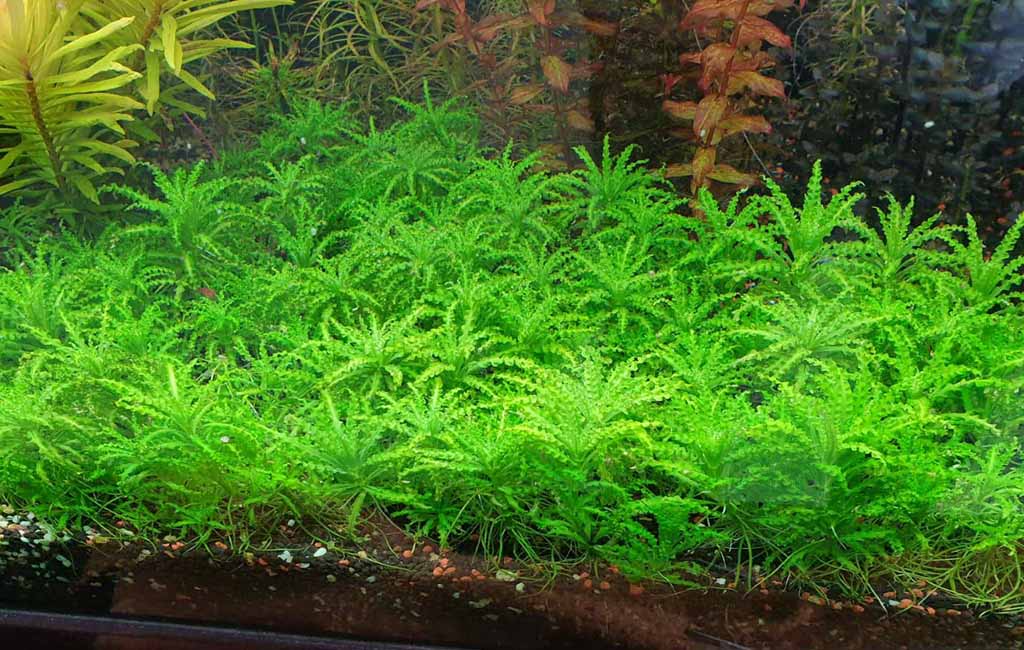
pogostemon helferi
What is Pogostemon Helferi
Pogostemon helferi belongs to the Lamiaceae family and is commonly known as mint, deadnettle, or sage. Experts discovered it in Thailand, near the Burma border. In Thailand, it’s called Downoi, which means little star as it appears like a star.
This beautiful plant is native to Southeast Asian regions, i.e., Thailand, Burma, India, etc. It grows in or between the calcium carbonate and oxygen-rich, fast-moving, and clear water streams, i.e., Kwai River and its tributaries.
Growth Characteristics
This unique beauty is easygoing. Here are some of the pogostemon helferi growth characters.
| Feature | Characteristic |
| Height | 3–10 cm |
| Spread | 5–15 cm |
| Growth rate | Medium |
| Leaf structure | Green, curly, and wavy. Grow in a rosette shape. |
| Light | Medium to high. LED and T5 lights are the most suitable. |
| Substrate | Nutrient-rich |
| Temperature | 72–82°F |
| General hardness | 0 – 30°dGH |
| Carbonate hardness | 2 – 14°dKH |
| Propagation | Runner Cutting |
Pogostemon Helferi Aquascape
Pogostemon helferi is a unique plant that helps in the tank’s aquascaping. They are used in the foreground and help to add texture and contrast to the tank. They are also helpful in creating a smooth transition between foreground and midground aqua-scaping elements with their thick and wavy leaves. Its unique growth and shape also make it a focal point.
What Kind of Aquascape Can You Create With Pogostemon helferi?
You can use it to create different aquascape styles. Here are the top three aquascapes where they are widely used.
Natural Aquascape
| It creates a thick green carpet at the bottom of the tank. For a natural look, grow it on rocks, driftwood, and other decoration surface. Mixing with other aquarium plants, i.e., java fern, anubias, and mosses, is also helpful for creating a more natural look in the tank. Mixing Pogostemon helferi with different shapes and sizes of plants helps to create a dynamic landscape in the tank. | 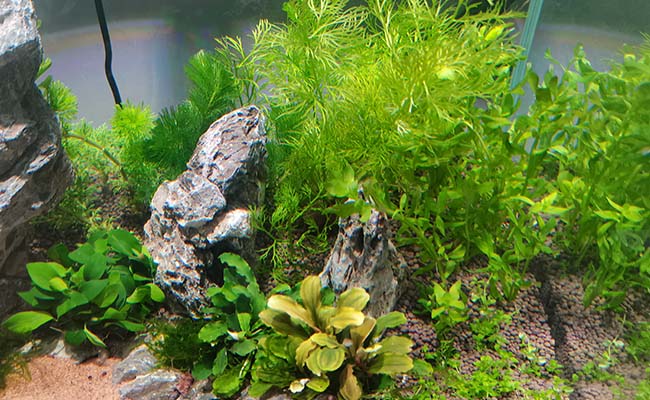 |
Iwagumi Aquascape
| If you want to make your tank design rocking with rocks, i.e., Dragon stone, use Pogostemon helferi as a foreground cover. It helps to soften the rock and give a smooth transition between rock and substrate or surrounding environment. It also creates a contrast of grey or white and green. | 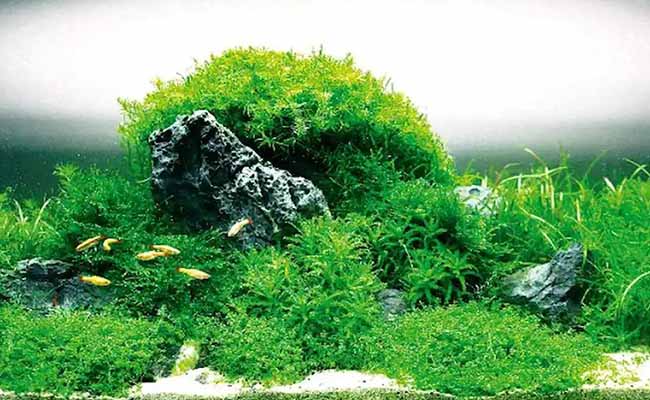 |
Dutch Aquascape
| In Dutch style, plants are grown in groups for structured and organized design. The foreground has small plants. The middle stage has taller plants than the foreground. The last row has the tallest plants. Pogostemon helferi is a great option for Dutch aquascpes. They serve as foreground plant layers and help to transition from foreground to midground plants. | 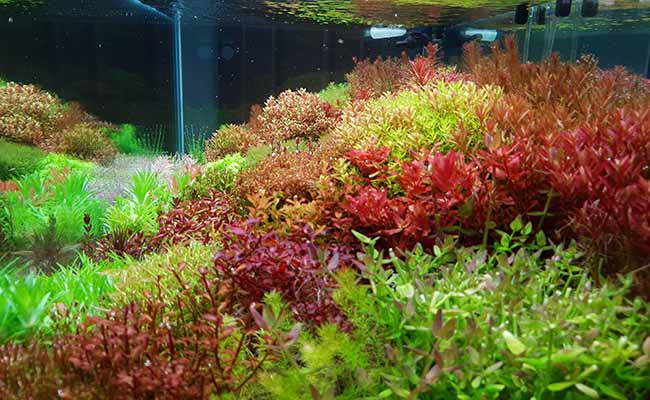 |
Stunning Pogostemon Helferi Planting
Pogostemon helferi can grow in soil or on hardscapes, i.e., driftwood, hardscapes, or other ornaments. Here is a step-by-step procedure for pogostemon helferi planting.
Plantation in Soil or Substrate
- Remove the plant from its container and wash it with unchlorinated water.
- The tank should be empty, but the substrate must be moist.
- Divide the plants into batches.
- Softly pick each batch with the tweezer. Hard picking can cause damage to roots.
- Plant it so that only the top tip remains visible at approximately 45°.
- Softly pull out the tweezer from the soil without disturbing the soil.
Plantation on Driftwood or Other Hardscapes
- Trim the roots up to 2cm.
- Split the plants into small batches with your hands.
- Apply fish-friendly glue to the hard surface.
- Push the root firmly on the glued surface.
- Instead of glue, you can use nylon thread to tie the plant to the surface.
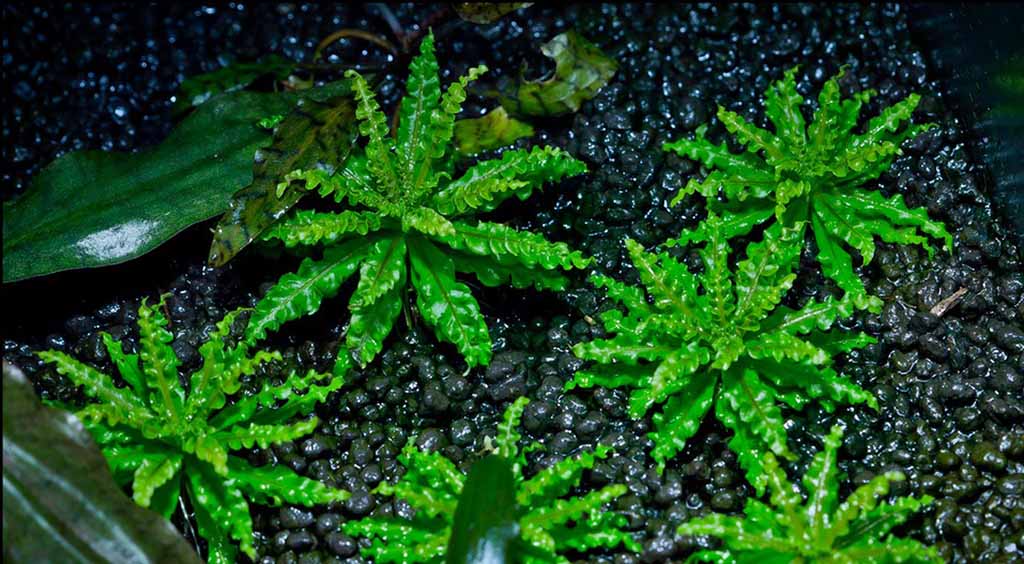
pogostemon helferi planting
Plant Care
Plant care is the next aspect of Pogostemon helferi aquascaping after plantation. Here is the Pogostemon helferi plant care guide.
- Maintain the proper water parameters, i.e., 72–82°F temperature, 6.0–7.5 pH, and 2–15dGH water hardness.
- Provide moderate to highlight. It promotes compact growth and attractive shape. Low light promotes longer roots that result in less compact growth.
- Always maintain the substrate’s nutrient level. To fulfill any nutrient deficiency, you can apply liquid fertilizers or nutrition capsules.
- Trim your Pogostemon helferi to promote bushy and optimal growth.
- In immersed conditions, provide your plant with high humidity.
- Always bring smooth changes, as fast changes can cause plant melting.
Pogostemon Helferi Melting
If your Pogostemon helferi leaves are shedding or dying off, it’s due to melting. Cure your plant to avoid further damage.
Reasons
| Low light | Weak nutrition | Stress on transferring into the new tank. |
Cure
- Enhance the light intensity up to medium. In worst cases, you can bring it too high.
- Apply liquid or capsule nutrients to the plants for nutrient deficiency.
- Maintain the optimal water conditions to avoid stress.
- Trim the melting plant’s leaves or branches. It’ll help you to avoid further damage.
Pogostemon Helferi Carpet
Pogostemon helferi is among the ideal plants for creating carpets in the tank. Follow the procedure to achieve it.
- Divide the plant into small batches.
- Plant each batch with a 3 to 4-cm distance.
- The soil, rock, or driftwood surface should be moist.
- Use a tweezer for the plantation.
- Plant them so deep that the only tip of the plant should remain visible.
- Provide intense light, as it ensures thick and denser growth.
- Remove the decayed or dying-off leaves.
Key Takeaways
Pogostemon helferi is a South-Asian plant that grows in Thailand and Burma. Its thick structure and easy handling make it a popular aquascaping choice. Therefore, aquarists use it in different styles, i.e., natural, Iwagumi, and Dutch aquascapes. For successful Pogostemon helferi planting, use rich soil and do proper care. You can also grow it on driftwood and other hard decors. Apply nutrients, in-time trimming, and take care of it to avoid melting.
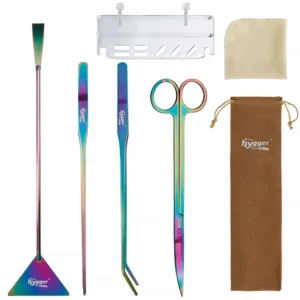
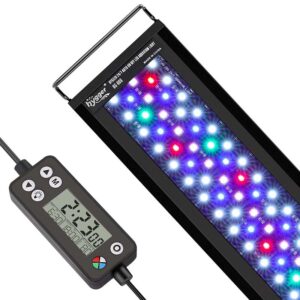
Leave a comment